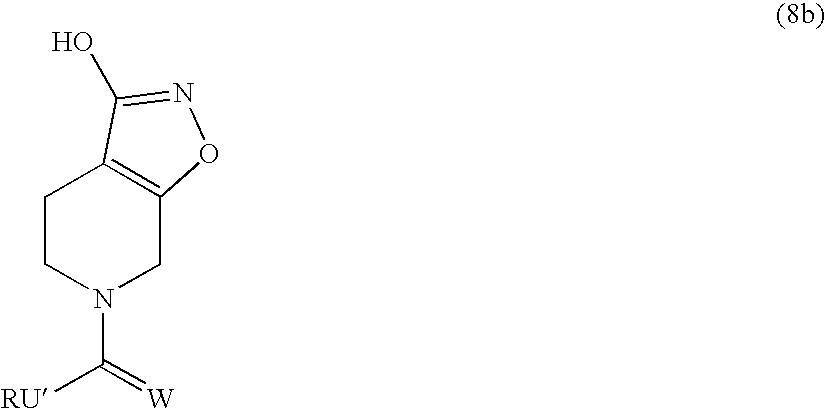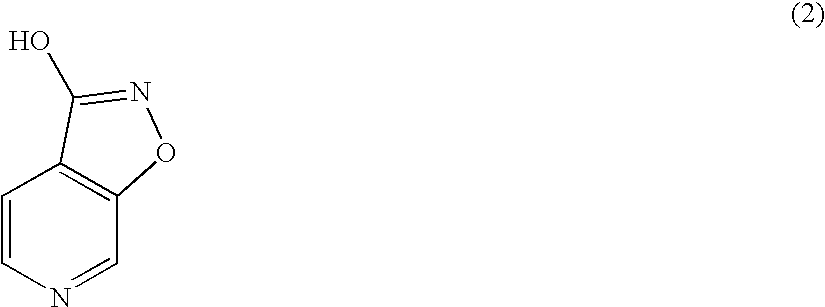Method for manufacture of thip
a technology of thip and manufacturing method, which is applied in the field of thip manufacturing method, can solve the problems of unselective benzodiazepines producing so many side effects
- Summary
- Abstract
- Description
- Claims
- Application Information
AI Technical Summary
Problems solved by technology
Method used
Image
Examples
example a
[0056]
3,N-Dihydroxy-isonicotinamide
[0057] To a stirred suspension of methyl 3-hydroxy-isonicotinate (176 g; 1.15 mol) in water / ice (50 / 50, 1700 mL), was added hydroxylamine hydrochloride (127.9 g; 1.84 mol). The temperature fell to −5° C. and then aqueous NaOH solution (454 mL, 28% w / v) was added dropwise keeping the temperature below 5° C. during the addition. Hereafter the reaction mixture was stirred at ambient temperature for 1.5 h followed by heating to 60° C. At this temperature the pH was adjusted to 5.4 by the addition of aqueous hydrochloric acid (10 M) at which point a heavy precipitate forms. The reaction mixture was then stirred at ambient temperature followed by cooling to 5° C. The pH was then adjusted to 4.0 by the addition of aqueous hydrochloric acid (10 M), and then was stirred whilst cold for 1.5 h. The crystals were filtered off, rinsed with water (3×100 mL), dried on the filter and then dried further at reduced pressure and 40° C. overnight to give 3,N-dihydrox...
example 1
[0064]
6-Benzyl-3-hydroxy-isoxazolo[5,4-c]pyridin-6-ium bromide
[0065] To a stirred solution of isoxazolo[5,4-c]pyridin-3-ol (50.0 g, 367 mmol) in NMP (100 ml) was added benzyl bromide (75.4 g, 441 mmol) dropwise rapidly. The thick solution was stirred for 24 h. The mixture was then added slowly to acetone (1.5 L) with stirring, and the solution was seeded. Stirring was continued at room temperature for 30 min, and then for a further 1 h in an ice / water bath. The mixture was filtered, the residue was washed with acetone and then dried under vacuum to give 6-benzyl-3-hydroxy-isoxazolo[5,4-c]pyridin-6-ium bromide (94.1 g, 83%; HPLC: 91% pure) as a white crystalline solid.
[0066] NMR data: 1H-NMR (DMSO-d6, 500 MHz) δ=6.03 (2H, s), 7.4-7.5 (3H, m), 7.6 (2H, m), 8.54 (1H, d, J=6 Hz), 9.03 (1H, d, J=6 Hz), 10.15 (1H, s) ppm.
example 2
[0067]
6-Benzyl-4, 5,6,7-tetrahydro-isoxazolo[5,4-c]pyridin-3-ol
[0068] To a stirred solution of 6-benzyl-3-hydroxy-isoxazolo[5,4-c]pyridin-6-ium bromide (93 g, 303 mmol) in ethanol / water (500 mL / 500 mL) was added NaBH4 (18.66 g, 494 mmol) cautiously portionwise, keeping the temperature under 35° C. (caution! Foams on addition!). The mixture was stirred for 24 h. The mixture was filtered, and the residue was washed with water. The combined filtrates were evaporated under reduced pressure until all of the ethanol had evaporated. A solid began to precipitate, and so the mixture was cooled in an ice-water bath with stirring for 30 min. The solution was filtered, and the residue was washed with cold water. The residue was dried to give 6-benzyl-4,5,6,7-tetrahydro-isoxazolo[5,4-c]pyridin-3-ol (48.6 g, 70%; HPLC 94% pure) as a yellowish solid. After some further evaporation of the combined mother liquors, a second crop gave a further 10.3 g (HPLC: 97.7% pure).
[0069] NMR data: 1H-NMR (DMSO...
PUM
| Property | Measurement | Unit |
|---|---|---|
| temperature | aaaaa | aaaaa |
| temperature | aaaaa | aaaaa |
| temperature | aaaaa | aaaaa |
Abstract
Description
Claims
Application Information
 Login to View More
Login to View More - R&D
- Intellectual Property
- Life Sciences
- Materials
- Tech Scout
- Unparalleled Data Quality
- Higher Quality Content
- 60% Fewer Hallucinations
Browse by: Latest US Patents, China's latest patents, Technical Efficacy Thesaurus, Application Domain, Technology Topic, Popular Technical Reports.
© 2025 PatSnap. All rights reserved.Legal|Privacy policy|Modern Slavery Act Transparency Statement|Sitemap|About US| Contact US: help@patsnap.com



